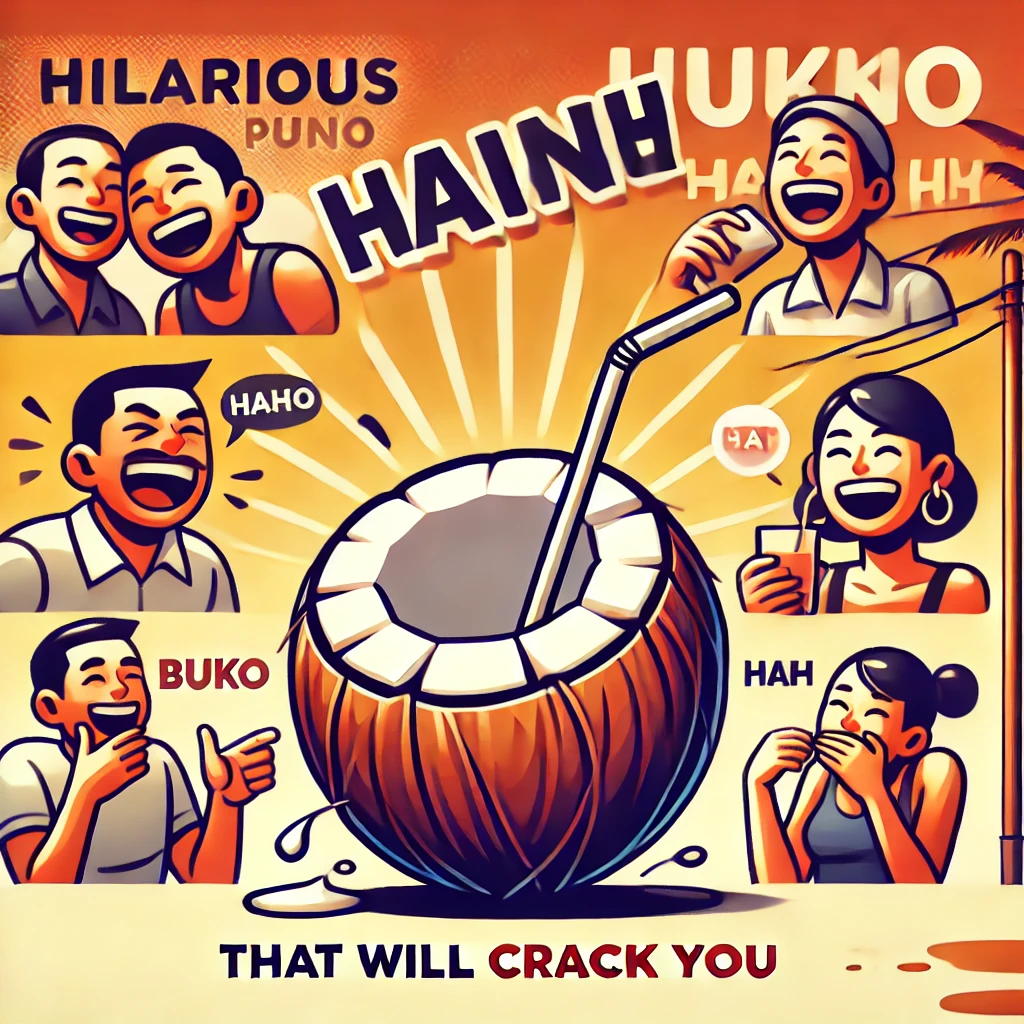Are you ready to dive into the world of Filipino humor? Buckle up, because we’re about to embark on a pun-tastic journey through the Philippines’ wit and wordplay! Filipino puns, or “punny” jokes as they’re often called, are a beloved part of the country’s rich cultural tapestry. These clever plays on words showcase the Filipinos’ love for language and their ability to find humor in everyday situations. So, whether you’re a Filipino looking for a good laugh or a curious foreigner wanting to understand the local humor, this blog post is your ticket to the wild and wacky world of Filipino puns. Let’s get started, shall we?
The Art of Filipino Wordplay
What Makes Filipino Puns Unique?
Filipino puns are a special breed of humor that combines the country’s love for language with its penchant for playful banter. These puns often rely on the unique characteristics of the Filipino language, including its melodic nature and the abundance of words with multiple meanings. What sets Filipino puns apart is their ability to seamlessly blend English, Tagalog, and sometimes even other local dialects to create hilarious wordplay that can leave you in stitches. The beauty of these puns lies in their simplicity and the way they can turn ordinary conversations into laugh-out-loud moments. It’s not uncommon to hear Filipinos cracking these jokes in casual settings, from jeepney rides to family gatherings, making humor an integral part of daily life in the Philippines.
The Cultural Significance of Humor in the Philippines
Humor plays a crucial role in Filipino culture, serving as a coping mechanism, a social lubricant, and a way to bond with others. In a country that has faced its fair share of challenges, from natural disasters to political turmoil, the ability to find humor in any situation is a valuable trait. Filipino puns are more than just jokes; they’re a reflection of the nation’s resilience and optimistic outlook on life. This cultural emphasis on humor has given rise to a rich tradition of wordplay and puns that continue to evolve with each generation. From traditional folk humor to modern internet memes, Filipino puns have stood the test of time and continue to bring smiles to faces across the archipelago.
Popular Categories of Filipino Puns
Food-related Puns: A Feast for the Funny Bone
Filipinos love their food, and it’s no surprise that many of their puns revolve around culinary delights. These food-related puns often play on the names of dishes or ingredients, creating hilarious double meanings that can make you both hungry and amused. For example, the phrase “Ano ang paboritong prutas ng mga pusit? Edi Squash!” (What’s the favorite fruit of squids? Squash!) plays on the similarity between “squid” and “squash” in English. Another classic is “Anong isda ang laging nasa hulihan? Edi, LAST-DINES!” (What fish is always at the back? Sardines!), which combines the English word “last” with “sardines” to create a punny punchline.
Name-based Puns: When Your Moniker Becomes the Joke
Filipino names are a goldmine for puns, with many common names lending themselves to wordplay. These name-based puns often rely on the similarity between a person’s name and another word or phrase, creating unexpected and humorous connections. A popular example is “Bakit malungkot si Rodrigo? Kasi Du-30 na siya.” (Why is Rodrigo sad? Because he’s already 30.), which plays on the name of former President Rodrigo Duterte and the number 30. Another classic is “Anong sabi ni Rizal nang makita niya si Josephine? I-Josefa you!” (What did Rizal say when he saw Josephine? I just have to see you!), combining the name of national hero Jose Rizal’s lover with a play on the phrase “I just have to see you.”
Situation-based Puns: Finding Humor in Everyday Life
Some of the most relatable and hilarious Filipino puns are those based on everyday situations. These puns take common experiences and twist them into unexpected jokes that can catch you off guard. For instance, “Anong tawag sa maliit na unan? Edi, pun-tahan!” (What do you call a small pillow? A little cushion!) plays on the Tagalog word “unan” (pillow) and the English word “one.” Another situational pun is “Bakit hindi naliligo ang mga tindera sa palengke? Kasi nag-titinda sila!” (Why don’t market vendors take a bath? Because they’re vending!), which cleverly uses the similarity between “tinda” (to sell) and “hindi” (not) to create a humorous explanation.
The Evolution of Filipino Puns in the Digital Age
Social Media and the Spread of Pinoy Humor
The rise of social media has given Filipino puns a new platform to flourish and reach wider audiences. Platforms like Facebook, Twitter, and Instagram have become hotbeds for sharing and creating new puns, allowing jokes to go viral within hours. This digital revolution has also led to the creation of meme pages and humor accounts dedicated to Filipino puns, further cementing their place in popular culture. The instant nature of social media has also encouraged a more rapid evolution of puns, with new jokes often emerging in response to current events or trending topics. This digital explosion of Filipino humor has not only entertained locals but has also helped showcase the country’s wit to a global audience.
Pun-derful Memes and Internet Culture
The internet age has given birth to a new form of Filipino puns: memes. These visual jokes often combine images with punny text, creating a potent cocktail of humor that’s easily shareable and relatable. Filipino meme creators have shown incredible creativity in adapting global meme formats to local humor, often incorporating puns that blend English and Tagalog. For example, a popular meme might feature a picture of a sad-looking person with the text “Bakit malungkot ang tindera? Kasi walang-benta.” (Why is the vendor sad? Because there are no sales.), playing on the dual meaning of “benta” as both “sales” and “funny.” These memes have become a significant part of Filipino internet culture, with new formats and jokes constantly emerging and evolving.
The Impact of Filipino Puns on Language Learning
Breaking the Ice: Puns as a Language Learning Tool
Filipino puns have found an unexpected use in language education, serving as an effective tool for both native speakers and foreigners learning the language. For Filipino students, puns help reinforce vocabulary and grammar rules in a fun and memorable way. For foreign learners, these wordplays offer insights into the nuances of the Filipino language and culture. Many language schools and tutors now incorporate puns into their lessons, using them to illustrate linguistic concepts and idiomatic expressions. This approach not only makes learning more enjoyable but also helps students develop a deeper appreciation for the playful nature of the Filipino language.
Bridging Cultures Through Humor
Filipino puns have also become a unique way of bridging cultural gaps and fostering understanding between Filipinos and foreigners. As more people around the world become interested in Filipino culture, these puns serve as a window into the country’s sense of humor and way of thinking. They often require an understanding of both English and Tagalog, making them an excellent tool for cultural exchange. Many expatriates and tourists in the Philippines find that learning and appreciating these puns helps them connect more deeply with locals and feel more integrated into Filipino society.
The Future of Filipino Puns: Keeping the Tradition Alive
Preserving Puns for Future Generations
As Filipino society continues to evolve and modernize, there’s a growing interest in preserving traditional forms of humor, including puns. Efforts are being made to document and archive classic Filipino puns, ensuring that these linguistic gems are not lost to time. Some universities and cultural institutions have begun including the study of Filipino humor and wordplay in their curricula, recognizing its importance as a cultural artifact. Additionally, there’s a growing movement among Filipino writers and comedians to create new puns that reflect contemporary life while staying true to the spirit of traditional wordplay.
Innovating with Tradition: New Trends in Filipino Puns
While preserving traditional puns is important, Filipino humor continues to evolve and adapt to changing times. New trends in Filipino puns include incorporating elements of pop culture, technology, and global events into wordplay. For example, puns related to smartphones, social media, and international celebrities have become increasingly popular. There’s also a growing trend of bilingual and even trilingual puns that combine Filipino languages with English and other foreign words, reflecting the country’s increasingly globalized outlook. These innovations ensure that Filipino puns remain relevant and entertaining for new generations of joke enthusiasts.
To illustrate the popularity of Filipino puns, let’s take a look at some data from a 2018 survey on humor preferences among Filipino youth:
| Type of Humor | Popularity (%) |
|---|---|
| Puns and Wordplay | 68% |
| Slapstick Comedy | 57% |
| Situational Humor | 62% |
| Satire | 45% |
| Dark Humor | 39% |
As we can see, puns and wordplay ranked highest among Filipino youth, demonstrating the enduring appeal of this form of humor.
In conclusion, Filipino puns are more than just jokes; they’re a vibrant reflection of the country’s linguistic diversity, cultural richness, and irrepressible sense of humor. From traditional wordplay to modern memes, these puns continue to evolve and entertain, bridging generations and cultures. So the next time you hear a Filipino pun, don’t just groan – appreciate the clever wordplay and the cultural heritage it represents. After all, laughter is a language everyone understands, and Filipino puns speak it fluently!
Disclaimer: This blog post is intended for entertainment purposes only. While we strive for accuracy in our content, some puns or jokes may not translate perfectly across all Filipino dialects or may have regional variations. If you notice any inaccuracies or have suggestions for improvement, please let us know so we can update our content promptly. Last updated: April 2018.




